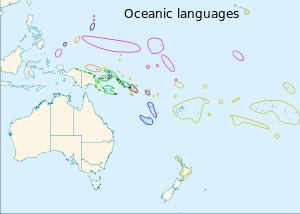Glottolog ocea1241 | ||
 | ||
Linguistic classification AustronesianMalayo-Polynesian (MP)Nuclear MP(Central–Eastern)Oceanic Subdivisions Admiralty Islands–YapeseSt Matthias IslandsWestern OceanicTemotuCentral–Eastern Oceanic | ||
Oceanic languages
The approximately 450 Oceanic languages are a well-established family of Austronesian languages. The area occupied by speakers of these languages includes Polynesia, as well as much of Melanesia and Micronesia.
Contents
Though covering a vast area, Oceanic languages are spoken by only two million people. The largest individual Oceanic languages are Eastern Fijian with over 600,000 speakers, and Samoan with an estimated 400,000 speakers. The Kiribati (Gilbertese), Tongan, Tahitian, Māori, Western Fijian and Kuanua (Tolai) languages each have over 100,000 speakers.
The common ancestor which is reconstructed for this group of languages is called Proto-Oceanic (abbr. POc).
Classification
The Oceanic languages were first shown to be a language family by Sidney Herbert Ray in 1896 and, besides Malayo-Polynesian, they are the only established large branch of Austronesian languages. Grammatically, they have been strongly influenced by the Papuan languages of northern New Guinea, but they retain a remarkably large amount of Austronesian vocabulary.
Lynch, Ross, & Crowley (2002)
According to Lynch, Ross, & Crowley (2002), Oceanic languages often form linkages with each other. Linkages are formed when languages emerged historically from an earlier dialect continuum. The linguistic innovations shared by adjacent languages define a chain of intersecting subgroups (a linkage), for which no distinct proto-language can be reconstructed.
Lynch, Ross, & Crowley (2002) propose three primary groups of Oceanic languages:
The "residues" (as they are called by Lynch, Ross, & Crowley), which do not fit into the three groups above, but are still classified as Oceanic are:
Ross & Næss (2007) removed Utupua–Vanikoro, from Central–Eastern Oceanic, to a new primary branch of Oceanic:
Word order
Word order in Oceanic languages is highly diverse, and is distributed in the following geographic regions (Lynch, Ross, & Crowley 2002:49).
